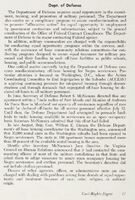Action to End Segregation in Suburbs
The Action Coordinating Committee to End Segregation in the Suburbs, or ACCESS, was founded by Joseph Charles Jones in June 1966. He had come to the Washington, D.C., to study at Howard University Law School. Jones was a rising civil rights activist and co-founder of the Shaw University branch of the Student Non-Violent Coordinating Committee (SNCC). He already launched large-scale demonstrations. Jones helped plan the 1963 March on Washington for Jobs and Freedom, which Dr. Martin Luther King Jr. led with many thousands joining him.
Observing the racial composition of suburbs surrounding Washington, DC, Jones described the demographics of this region as a “white ghetto surrounding the black ghetto.” He wanted to integrate both "ghetto[s]" and secure affordable housing for their residents. Jones knew that he had to moblize different people to accomplish these goals. So he organized a major protest march to cover the entire 65 miles around the Capitol Beltway. His primary aim was to bring attention to patterns of segregated housing. Demonstrators started their walk on 8 June 1966 and continued with their procession for four days alongside multi-lane traffic. The group traveled 15 to 20 miles during daylight hours, encountering adversaries who shouted obscenities and embracing supporters who delivered food baskets and drinks to satisfy the summer thirst.[1]
Years before J. Charles Jones began his law program at Howard University, housing discrimination and community displacement were major concerns of Black Northern Virginians. A retrospective report co-written by the Fairfax Branch of the NAACP and the Northern Virginia division of the Washington Urban League delved into the history of these issues; the two organizations found that the low incomes of Black people and unequal treatment of "minority residents of Fairfax County" contributed to the problems, which Jones was seeking to address in 1966. While the NAACP chose to pursue a path of government advocacy and court action, ACCESS focused on public protest. [2]
Jones and leaders of ACCESS arranged for a second march in Northern Virginia, which took place over three days in early October 1966. They had mustered 25 demonstrators to begin walking from Gum Springs, a Black community in Fairfax County, to Alexandria and Arlington counties. Along the way, the protestors held rallies at different sites such as the James Bland public housing development, a Black community in Alexandria, and Buckingham apartments, an all-white residential area in Arlington. The well-appointed Buckingham apartments had drawn picketers before because it was known for its discriminatory practices. [3] The James Bland homes in Alexandria were rundown symbols of housing inequality and crisis for Black people of Northern Virginia. [4] A culminating rally in Lubber Run Park (Arlington) was confronted by members of homegrown terror groups such as the American Nazi Party and KKK. ACCESS marchers held their ground and no violent incident was recorded.
The marches and other demonstrations led by ACCESS prompted the Department of Defense to accept Jones’ suggestion of banning service members from living in segregated housing near Andrews Air Force Base in Maryland. This governmental decision put pressure on neighboring landlords to reconsider their discriminatory practices.
By Sira Anissa I Thiam
[1] John Kelly, “‘I Feel as If I Own This Road’: A Civil Rights Figure Who Was in It for the Long Haul.” The Washington Post. October 11, 2016. https://www.washingtonpost.com/local/i-feel-as-if-i-own-this-road-a-civil-rights-figure-who-was-in-it-for-the-long-haul/2016/10/11/40f55c72-8f0b-11e6-9c85-ac42097b8cc0_story.html. A scholarly overview of this period of protest is provided here: Simon Hall, "Civil Rights Activism in 1960s Virginia," Journal of Black Studies 38, no. 2 (2007): 251-267.
[2] Denton L. Watson, "Reassessing the Role of the NAACP in the Civil Rights Movement," The Historian 55, no. 3 (1993), 453; “Urban League, NAACP Urge County to Help Minorities.” The Fairfax
[3] Richard Taffe, "Hobbs Hits Attack by Broyhill." Northern Virginia Sun. October 6, 1966. https://virginiachronicle.com/?a=d&d=NVS19661006.1.1&srpos=9&e=--1965---1966--en-20--1--txt-txIN-%22Buckingham+Apartments%22-------
[4] Krystyn R. Moon, "The African American Housing Crisis in Alexandria, Virginia, 1930s–1960s," The Virginia Magazine of History and Biography 124, no. 1 (2016): 28-68.


